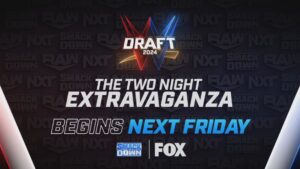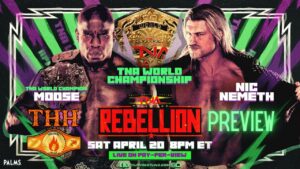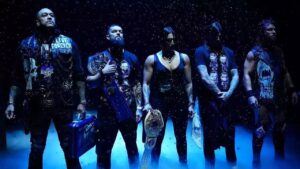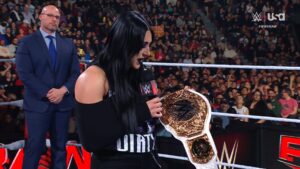Last night at Ring of Honor‘s War of the Worlds joint production with NJPW saw Bullet Club superkick Adam Cole out of the group. Considering that his ROH deal had recently expired (and the countless rumours of him heading to NXT), his departure was not unexpected. What was a twist on the end of Cole’s tenure with Bullet Club, one of the most popular factions in the history of professional wrestling, was the addition of ROH Television Champion “The Villain” Marty Scurll, whose appearance following a cryptic goodbye message from Bullet Club’s leader Kenny Omega, signalled Cole’s end with the Club. It was a huge moment with the live crowd and the internet alike. And once again, the dynamics of Bullet Club changed.
https://www.youtube.com/watch?v=KQhapzD7JkY
Once again, just as everyone had counted Bullet Club out, that the faction was on it’s last legs, in one powerful moment, gained back any momentum the naysayers suggested they had lost. One might argue that replacing Adam Cole with Marty Scurll is one of the most significant upgrades in the history of Bullet Club. Sure, Adam Cole is an ROH legend and the only 3-time ROH World Champion in its history, but Cole has gone as far as he can go on the indie circuit. It’s time he stepped up a ladder and reinvented himself, most likely in NXT. But right now, Scurll is one of the hottest properties in pro wrestling (with all due respect to CHIKARA‘s Fire Ant). Adding Scurll will strike a stronger accord with younger indie fans – the crux of Bullet Club’s demographic – than Adam Cole has done so far with his tenure in the group. And so Bullet Club not only lives for another day, but will continue to thrive. Which is it’s greatest accolade – the factions longevity.

Which brings us to the discussion at hand. Bullet Club was initially a group that paid a lot of homage to the nWo of WCW – from it’s black and white colours, the shirts that became uniforms, not only for its members but its fanbase, to the Kliq’s “Too Sweet” hand gesture that the nWo brought to the public forefront, to the crotch chops from DX (another group that featured Kliq members), to Kenny Omega’s reference to the Young Bucks and Adam Cole hugging as a “curtain call” last night (alluding to the infamous WWF ‘Curtain Call’ between the Kliq that lead to the invasion of Scott Hall and Kevin Nash). Like the nWo in WCW over 20 years ago, the Bullet Club were a gang of invading stars, grouped with some malcontents within the organization, whose goal became the domination and corruption of the very promotion it fought within. Bullet Club has never denied that lineage – in fact, they’ve often tweeted pictures of them Too Sweeting former nWo members like Scott Hall, Kevin Nash and Sting, or crotch chopping with X-Pac (aka Syxx). Scott Hall’s son, Cody Hall, is a former Bullet Club member, bringing bloodlines together.

Another similarity is the pure merch machine both factions have been for their respective promotions. nWo shirts were the highest selling merch in WCW for years and continue to be big sellers for the WWE, while Bullet Club merch are the biggest selling items for outlets like Pro Wrestling Tees and NJPW. Wearing one is not just like throwing on a random T-Shirt, it means you are a part of the gang by proxy. Bullet Club – like the nWo before them – are as much about being part of a movement as it is about simply showing colours. The members of Bullet Club – particularly the Young Bucks – are fans of the industry and it’s rich history. They’re as much about the past as they are about changing the future. But unlike their forefathers in the nWo, Bullet Club has managed to not only remain viable and relevant despite it’s large amount of departures, turns and additions, but thrive on that change, something that the nWo was unable to do. And it is that very reason that perhaps it’s time to give credit where credit is due – that perhaps it’s time to admit that, while it’s true there would be no proper Bullet Club without the nWo, Bullet Club has now surpassed the nWo as the superior gang in pro wrestling history (well, at least amongst ones not named the Four Horsemen, but even that is a strong debate).
The nWo and The Bullet Club: ORIGINS
Both factions began at a major PPV, both with beloved fan favourites turning on the promotion and its fans, and both declaring war on the opposition. On July 6, 1996, the New World Order was created when WCW’s top face, Hulk Hogan, turned heel for his first since before Hulkamania, and aided Scott Hall and Kevin Nash at Bash At The Beach. Hogan declared a New World Order was here to change wrestling. And thus, the nWo was born. On May 3, 2013, at NJPW’s PPV Wrestling Dontaku, Prince Devitt (aka Finn Balor) and Bad Luck Fale – who’d previously in the event teamed up to defeat Devitt’s former tag partner in Apollo 55, Ryusuke Taguchi, and NJPW “mascot” Captain New Japan (who would join Bullet Club in 2016 as Bone Soldier) – came down to the ring following Karl Anderson‘s loss to Hiroshi Tanahashi, where Anderson was being consoled by his friend at ringside, Tama Tonga (the son of WWE Legend Haku). With Devitt and Tonga initially looking to face off against the two intruders, they instead joined the duo in beating down Tanahashi. And thus, Bullet Club was formed. Both began with a sinister beat down of a beloved icon – “Macho Man” Randy Savage and Hiroshi Tanahashi.

Both also had frameworks in previous storylines that had laid the foundation for the grand reveal as well. Devitt had only turned on his Apollo 55 tag partner a few weeks earlier, when he and his bodyguard, “The Underboss” Bad Luck Fale, decided it was all about Finn now. NJPW fans were shocked that their beloved favourite had gone to the darkside. Leading up to WCW’s Bash At The Beach, Nitro was first invaded by Scott Hall (who had recently left WWF as Razor Ramon) and then by Kevin Nash (who had just been Diesel in WWF for years). They announced a secret Third Man for their Bash at the Beach debut and low and behold, Hulk Hogan came out as the surprise leader of the trio.

EDGE: Both were huge shakers of a debut, but the edge here has to go to the nWo. It not only changed the course of WCW and the Monday Night Wars, it shifted an industry. It’s one of the biggest moments in wrestling history. Sure, in hindsight, Bullet Club’s debut was pretty cool and calculated but it wasn’t as much of a game changer as the nWo’s was – when the nWo was first on the screen, everyone knew something big was afoot. Bullet Club raised some eyebrows, but not many expected Bullet Club to become the phenomenon it has become.
The nWo and The Bullet Club: SHAKE-UPS
One thing that has remained the punch line of the entire nWo run, from it’s debut in 1996 until it’s final ending in WCW in 2000, was the insane amount of members it collected during it’s four year tenure. Their shirts changed so often, from WCW alliance to nWo, from Wolfpaq to Black & White, to nWo 2000, that it was hard to keep track just who was in the group at any given time. All said and done, sixty two (62) different wrestlers were a part of the nWo during its four year reign. So far, in the same amount of time (four years), there have been twenty eight (28) people to don a Bullet Club shirt.

Part of the intrigue of both groups was and is the unpredictability of who could possibly join – or get kicked out – and when. They were always big moments of any television episode or PPV something occurred on. For most of the shake ups that have happened with Bullet Club, however, the group has gotten stronger and more concentrated. While with the nWo, it just got more diluted and laughable. When you’re just Hulk Hogan, Razor Ramon and Diesel, you’re bad-ass. When you start adding Virgil, Stevie Ray and Horace Hogan, you’re just taking advantage of sheer laziness. Sure, Bullet Club has had a few duds – Bone Soldier, we’re looking at you – but for the most part, Bullet Club has replaced every member with a better option. And that includes changes in leadership.

Again, both groups experienced loss in the management department, losing major names, only to replace them with other big names. But both groups didn’t make the transitions as seamlessly. In April of 1998, dissension in the nWo ranks started, as Kevin Nash and Randy Savage began to grow wear of “Hollywood” Hogan’s narcissism and left to start their own nWo group, dubbed nWo Wolfpaq, and they recruited the one man Hogan had been unsuccessful in recruiting – Sting. By November of 1998, Hogan retired, placing the leadership mantle of the original nWo in the hands of “Big Poppa” Scott Steiner. Hogan would return in 1999 and close the wounds, reforming the full nWo. This time, there would be two nWo tiers – nWo Elite, featuring Hogan, Nash, Hall, Steiner, Lex Luger and other main eventers, and nWo Black & White, foot soldiers lead by Stevie Ray and featuring Scott Norton, Brian Adams, The Giant and others. The original nWo would end in August of 1999, before being reformed by Kevin Nash and Scott Hall, along with Scott Steiner and newcomers Bret ‘Hitman’ Hart and Jeff Jarrett, as nWo 2000, with Hart assuming the leadership role. Following his sudden retirement due to concussions, Jeff Jarrett would become the final leader of the nWo in WCW. In their four year run, the nWo had six different men in a position of leadership. But no one ever truly eclipsed the original vision and leadership of Hulk Hogan in the original run.

From the outset, Bullet Club was Prince Devitt’s group. He assembled the roster, bringing in the Young Bucks and Doc Gallows, who would pair up with Karl Anderson. But after only a year, Devitt was turned on by the Young Bucks following his Loser Leaves Town match against his old rival Taguchi at NJPW Invasion Attack in April of 2014. Shortly after, Devitt would show up in NXT, now under the name Finn Balor. Karl Anderson assumed leadership on an interim basis, until AJ Styles showed up. It was then that Bullet Club created their American chapter, with AJ Styles leading the charge in Ring of Honor, and Karl Anderson leading the Japanese chapter. In both promotions, they grew in corruption, main eventing both. Bullet Club would also appear at events for CHIKARA and others, as rogue mercenaries. Two years later, Styles would suffer the same fate as Devitt, backstabbed by the Young Bucks, in a coup that would see Kenny Omega assume leadership and Anderson and Gallows silently removed from the group (all three would end up in the WWE within weeks). Later in the year, they would recruit Adam Cole to assume the leadership of the ROH/American chapter, a job he was ultimately fired from last night. Omega continues to guide the new face of Bullet Club, as just the fourth leader in the group’s four year history. And much like the restructured hierarchy of Hogan’s return to the nWo in 1999 created the top tier faction “nWo Elite”, following Styles’ firing, Omega would structure the NJPW faction as the dominant branch (and calling his main leadership with the Young Bucks as The Elite), with the American chapter a tier below. Bullet Club Black & White so to speak.

EDGE: No question the nWo had some big name leaders in their run – Hulk Hogan, Kevin Nash, Scott Steiner, Bret Hart – but each leadership change just caused more cracks in the group’s legacy. By the time nWo 2000 came around, it felt more like when a classic rock band goes on tour with just the original bass player, but not the singer, guitarist or drummer. It felt like a knock off, a bad copy. Bullet Club has grown with each change in direction, not stagnated. And with the ever growing membership, it just didn’t feel as cool or special, when you’re current line-up boasts over thirty members. With Bullet Club, it’s smaller size, and diversified chapters, have kept their involvement to more sneak attacks and chaos, so have felt more genuine of gang warfare. And each time the leadership has changed, the Club has come back stronger. Although it may be wise for any leadership potentials to be weary of the Bucks – they’ve personally sent three different leaders packing with a Superkick Party.
The nWo and The Bullet Club: INTERNATIONAL CHAPTERS
Both also had chapters in multiple promotions around the world. The nWo’s main branch was obviously the USA, but at the time, WCW also had a working arrangement with NJPW. So naturally, they had an nWo Japan (or nWo Gundam as they were called in Japan). It featured three NJPW legends, Masahiro Chono, Hiro Saito and Hiroyoshi Tenzan as the group’s leadership, and later joined by Keiji Mutoh (under the name The Great Muta), Tatsutoshi Goto, Michiyoshi Ohara, AKIRA and Satoshi Kojima. Various American members would frequent various live events, including Scott Norton, who won the IWGP Heavyweight title.

On the flipside, Bullet Club’s main branch is the NJPW chapter, with satellite branches in Mexico (CMLL‘s Bullet Club Latinoamerica, with Rey Bucanero, El Comandante, Mephisto, and Terrible) and the USA (Ring of Honor, featuring AJ Styles for two years, Adam Cole, Cody Rhodes, and Hangman Page). With the addition of Marty Scurll last night, NJPW could be thinking of expanding to a fourth chapter, one in the United Kingdom. After all, NJPW currently also has a working agreement with Revolution Pro in England. Could Scurll lead a UK-based version, and still work for ROH and NJPW? Add appearances in such promotions as CHIKARA and PWG, plus the creation of The Club in WWE, with former Bullet Club members AJ Styles, Karl Anderson and Luke Gallows, and you could argue they had a plant in far promotions than any other faction has before.

EDGE: nWo was a powerful entity in WCW, but in NJPW they were more of a spectacle or attraction. But Bullet Club is as equally imposing whether it’s in ROH or NJPW. Bullet Club has had a longer and stronger success story with their international branches than the nWo ever did.
The nWo and The Bullet Club: CHAMPIONSHIP REIGNS
The final comparison is the championships these factions accumulated. And they were a lot. And like each other, they collected hardware from both sides of the world. Here’s a look at the trophy cases for each faction (titles won while a member of the faction or held when joined).

nWo Trophy Case
Championships: 36
Tournaments: 5
WCW World Heavyweight Champions: ‘Hollywood’ Hulk Hogan (4), ‘Macho Man’ Randy Savage, Kevin Nash (2), Bret ‘Hitman’ Hart
IWGP Heavyweight Champions: Masa Chono, Scott Norton, The Great Muta
WCW US Champions: Curt Hennig, Bret Hart (3), Lex Luger, Scott Hall, Scott Steiner, Jeff Jarrett (2)
WCW Television Champions: Konnan, ‘Big Poppa Pump’ Scott Steiner, Scott Hall
WCW Cruiserweight Champions: Syxx
WCW World Tag Team Champions: The Outsiders (Kevin Nash & Scott Hall, 5), Sting & The Giant, Sting & Kevin Nash, Scott Hall & The Giant, The Harris Twins
IWGP Tag Team Champions: Masa Chono & The Great Muta, Masa Chono & Hiroyoshi Tenzan, Hiroyoshi Tenzan & Satoshi Kojima
WCW World War 3: The Giant (1996), Scott Hall (1997), Kevin Nash (1998)
NJPW World Tag League: The Great Muta & Satoshi Kojima (1998), The Great Muta & Scott Norton (1999)

Bullet Club Trophy Case
Championships: 36
Tournaments: 4
IWPG Heavyweight Champions: AJ Styles (2)
ROH World Heavyweight Champions: Adam Cole (2)
CMLL World Heavyweight Champions: Terrible
IWGP Intercontinental Champions: Bad Luck Fale, Kenny Omega
IWPG Junior Heavyweight Champions: Prince Devitt, Kenny Omega (2)
NEVER Openweight Champions: Takahashi
ROH Television Champions: Marty Scurll
WCPW Internet Champions: Cody Rhodes
CMLL Mexican National Light Heavyweight Champion: Mephisto
IWGP Tag Team Champions: Anderson & Gallows (3), Guerrillas of Destiny (Tama Tonga & Tanga Loa, 2)
IWGP Junior Tag Team Champions: The Young Bucks (5)
NEVER Openweight 6-Man Tag Team Champions: Bad Luck Fale, Takahashi & Tama Tonga, The Elite (Kenny Omega, The Young Bucks, 2)
ROH World Tag Team Champions: The Young Bucks (3)
CMLL World Tag Team Champions: Terrible & Tama Tonga, Rey Bucanero & Tama Tonga
PWG World Tag Team Champions: The Young Bucks (2)
WrestleCircus Big Top Tag Team Champions: Guerrillas of Destiny
NWA Women’s World Champions: “Bullet Babe” Amber Gallows
NJPW G1 Climax: Kenny Omega (2016)
NJPW Best of the Super Juniors: Prince Devitt (2013)
NJPW Super Juniors Tag Tournament: The Young Bucks (2013)
NJPW World Tag League: Anderson & Gallows (2013)
EDGE: With the exception of one tournament win, both factions won exactly the same amount of major titles in four years. Shockingly, nWo had more members win the IWGP Heavyweight Championship than Bullet Club, but both sides feature some strong title holders. If Bullet Club had any edge over nWo, it would be some of the lengthy reigns their members held titles for…and Bullet Club never had a Finger Poke of Doom.

By the time the nWo died in WCW in 2000, it was a shadow of its former self. It was more of a euthanasia than a sad moment. What had been one of wrestling’s greatest game changers had morphed into it’s saddest Las Vegas lounge act. But as Bullet Club enters it’s fourth year, they are just as hungry, determined and popular as they’ve ever been. And with last night’s addition of “The Villain” Marty Scurll to its ranks, you can expect them to take over the nWo’s trophy count in no time.
Like Kenny Omega said to Adam Cole last night: “Just like all fairy tales, there has to be a hero, and there has to be a villain.

nWo Logo: WWE; Bullet Club Logo: NJPW
FOR MORE WRESTLING NEWS, JOIN OUR FACEBOOK GROUP!







